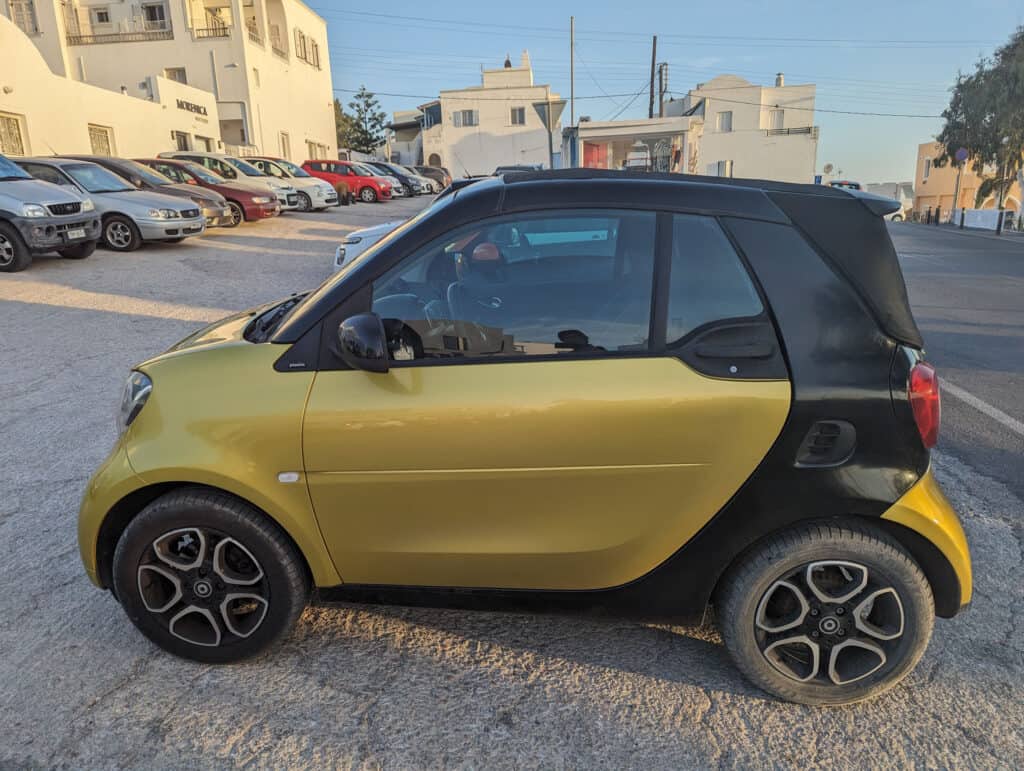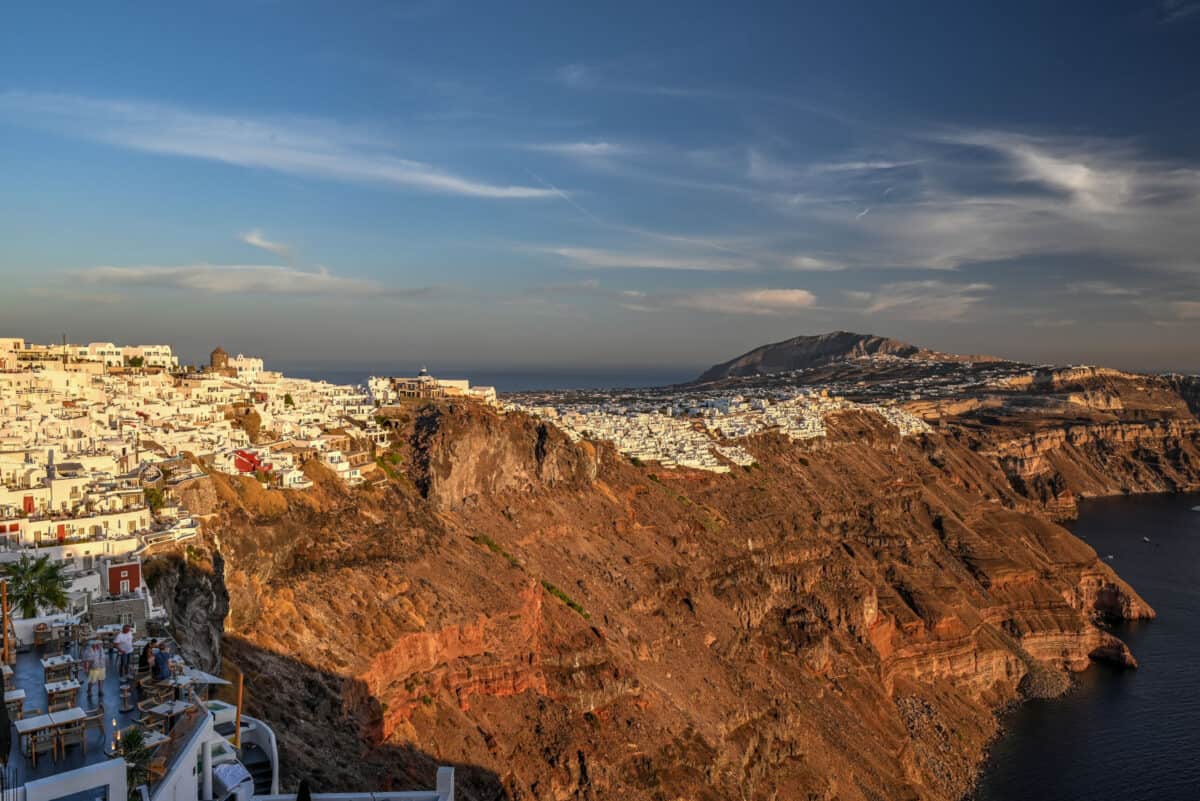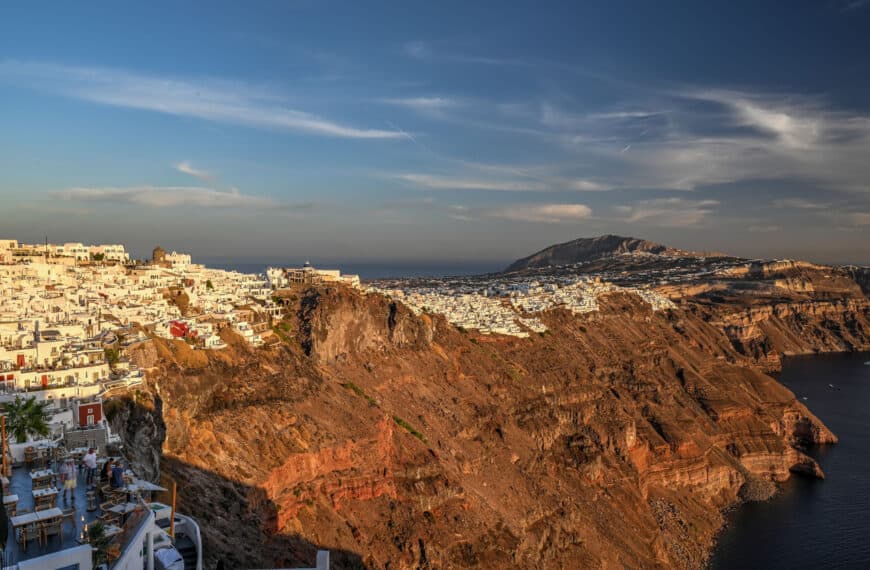Have you started planning your trip to Santorini but are unsure about the best way to get around the island? Should you rent a car or ATV? Are the buses reliable? Can you easily get a cab? Can you walk between villages? It can definitely be overwhelming when considering all the options, so we are here to help. Having spent five days on the island, we feel that we have developed a good grasp of what works and what doesn’t, and what options you should consider prioritizing in given scenarios. Below you will find our travel guide on how to Get Around Santorini, which we hope will help you maximize your time spent on this idyllic island.






Being such a small island, you are never truly far from anywhere on Santorini. In the absence of significant traffic, you can easily drive across the island in under an hour. It’s in part because everything is so close to everything else that deciding on the best method of transportation is complicated: every option seems like a potentially good option and it is hard to tease them apart.
The abuse rides are quick and cheap, but you generally need to take at least two of them to get anywhere unless you are staying in Fira. Driving in Santorini is generally straightforward, but car rentals can be expensive. You can walk between certain villages, but not between others. Taxis are nearly impossible to find. ATVs and scooters are a popular choice but can be dangerous, particularly for inexperienced drivers.
To help make some sense of all of the available options, we will cover each of them separately below. We will also highlight the special cases of arriving in Santorini via the Airport, the Athinios (New) Ferry Port or the Old Port (cruise ship terminal). We will also provide advice on how to best mix and match different transportation methods with different activities and destinations to optimize your travels in Santorini.
Disclosure: This page (How To Get Around Santorini) may contain product affiliate links. At no additional cost to you, we may receive a commission for purchases made through these links. More details can be found on our disclosure and policies page.
You might also be interested in these pages:
Best Things to See and Do in Santorini
Santorini Itinerary Ideas (1 to 5 days)
Santorini Travel Guide: Things to Know Before You Go
Where to Stay on Santorini
Santorini Buses
Santorini’s bus network connects the vast majority of villages and attractions, making them a very convenient option to travel around the island. On top of that, one-way bus rides are relatively cheap (typically under 3€ (2024)), making them a great option for budget-conscious travellers. Santorini’s local buses are run by a company known as KTEL and they operate year-round. However, there are significantly more bus routes that operate during the summer and shoulder season.
One of the main drawbacks to using the bus system in Santorini is that buses are not very frequent (at most twice per hour). Another is that every bus route has the Fira bus station as a start or endpoint. This implies that if Fira is neither your start or end point, you will likely have to transit there and then take a second bus. That being said, almost every destination on the island is at most 30 minutes from Fira. The main bus lines connect Fira to Oia, Perissa, Kamari (with stops in Megalochori and Pyrgos), Imerovigli (with stops in Firostefani), Akrotiri (with stops in Megalochori), the Santorini Airport, and the Santorini Ferry Port (New Port), in addition to a few other destinations.
We’ve used the bus a few times during our time in Santorini and found it to be one of the best ways to get around Santorini when you only plan on visiting one or two places in a day, especially if Fira is one of them (or if Fira is your starting point). If you want to visit several places and attractions in a single day, we suggest renting a car instead (more on vehicle rentals below).
Important Santorini Bus Facts:
-Bus schedules for the whole island can be found on the KTEL website. Note that the current schedule is posted and changes throughout the year, with increased service during the high season (so the schedule you see now might not be the same when you visit).
-Bus fares are paid directly to the bus driver, and only cash is accepted. So be sure to carry some coins with you if you plan on using the bus in Santorini. There are no advanced sales of bus tickets. All tickets are one-way with no transfers.
-The Fira bus station can be a chaotic place. There are no clear waiting lines, people are just all over the place trying to figure out which bus to take. We suggest you arrive at the bus station early to give yourself enough time to find your bus. The final destination is generally listed on a yellow sign in the lower-left corner of the bus window. If you are unsure, please ask the driver, especially if your desired destination isn’t a final stop, such as Pyrgos or Megalochori.

-Some infrequent night buses are added to the schedule during the summer high season.
-Santorini buses are air-conditioned.
-Only Fira has a central bus station. Every other location or village only has bus stops, most of which are generally easily recognizable (see image below). If you are not sure where the nearest bus stop is, you can check and search Google Maps where most of them are listed.

-If catching the bus from a bus stop on the street, flag down the bus to let the driver know to stop, otherwise they might not stop. They may not stop either if the bus is full.
-The Fira-Athinios (Ferry Port) route changes its schedule every day according to the ferry schedule.
-If you have a lot of luggage, buses might not be ideal as they are often jam-packed during high season. Instead, we would recommend pre-booking a private transfer (see below).
Driving (ATV/scooter rentals)
ATVs (quad bikes) and scooters are popular options in Santorini, but we don’t particularly recommend them unless you are very experienced driving one or the other.
For scooters, you need a motorcycle permit to be able to use one. For ATVs, you are required to hold a regular driver’s permit (in addition to your international driver’s permit (IDP)). But neither scooters nor ATVs are suited for driving in Santorini, particularly when handled by inexperienced tourists. Roads in Santorini are notoriously narrow, winding and steep in places, making it difficult to handle ATVs and scooters. Accidents are a common occurrence and, sadly, it seems that every year there are several fatalities due to road-related ATV and scooter accidents.
It’s also important to know that many, if not most, travel insurances (such as those that come with your credit card) that normally insure your rental vehicle WILL NOT insure an ATV rental. Unless you have a fair amount of experience with either vehicle type, our advice is to rent a small car to get around the island more safely.
If you have your heart set on riding an ATV while on Santorini, a safer option would be to join an organized ATV group tour of the island that comes with more instruction on safety and use, in addition to having you follow a guide.
Driving (Car rentals)
You don’t need to have a car in Santorini, but having your own rental car is the simplest and most practical way to get around Santorini when you want to visit several distant places on the same day. For instance, if you want to visit the Akrotiri Archeological Site, a black sand beach and a beautiful vineyard on the same day, using the bus system will be a hassle as you will almost surely have to transit back to Fira each time. We might be biased as we love road trips (hence the name of the website), but if you plan on fully exploring the different corners of the island, having a rental might be the best choice, even if it’s just for a portion of your time in Santorini.
One important drawback is that car rentals can be expensive in Santorini, but you can generally get better deals if you book ahead. You’ll almost always pay more if you decide to rent up on the spot.
If you haven’t booked your rental vehicle yet, we highly recommend using Discover Cars to get the best rates on your rental in Santorini.
Because of the costs associated with renting a car in Santorini, and since it was necessary for all of our plans, we opted to rent one only for a part of our stay in Santorini island. Having the rental car made visiting several more distant places on the same day a more seamless process than it would have otherwise been.
There are lots of different pick-up locations throughout the island, including in most villages. Because we were based in Imerovigli, we chose Sun Bird Car Rental as our pick-up location (booked through Discover Cars). It’s one of the best-rated car rental agencies on the entire island.
Parking: Finding spots to park in places like Fira and Oia can be challenging, particularly during high season and as such we don’t recommend using a car to visit one or the other. You can either use the direct bus between Fira and Oia or walk along the stunning Caldera trail between Fira and Oia. Elsewhere parking is easier, but you might still come across a full parking here and there if looking for a spot midday. Parking lots are generally located around a village or along its periphery, a short walking distance from the village center.
All public parking lots in Santorini are free (2024). We specify some of the best parking lots for each village in our Guides for Fira, Imerovigli, Oia, Pyrgos, Megalochori, Kamari and Perissa.
Petrol: Filling up isn’t cheap in Santorini, but given the island’s small size you are unlikely to burn through a tank very quickly.
Car size: We highly recommend renting the smallest vehicle size you are comfortable with. It makes parking in tight spaces and navigating certain roads significantly easier (not to mention that smaller vehicles tend to be less expensive). We had lots of fun driving our little Smart around the island.

International Driver Permit: Most car rental agencies will require that you have one if you live outside the EU.
Side of the road: Driving is on the right.
Driving age: The minimum age is 17, but most car rental agencies will require that the driver be at least 21 with at least one year of prior driving experience.
Mandatory insurance: third-party liability insurance – it is automatically included in the price of all car rentals.
Roads: Most roads in Santorini are paved roads and are in decent condition. Be aware of the occasional pothole.
Roads between villages are generally large and easy to navigate. Roads within villages require greater care as they are typically quite narrow and often without sidewalks for pedestrians.
ATVs (Quads) and Scooters: Beware of others driving on these vehicles, as they can be reckless, particularly other tourists.
Accidents: In case of an emergency dial 112.
Taxis
Taxis aren’t a great option on Santorini – there are roughly only 40 taxis that operate on the island, meaning it can be very difficult to find one at times. Taxis in Santorini aren’t on a meter or transparent fixed price system and negotiation is often required before any trip, which is a hassle most people would like to avoid. In our opinion, your best option is to pre-book and private transfer in situations where you want to use a taxi.
Private Transfers
Although private transfers are mostly used to get to and from the airport or the ferry port, they can also be a good option if you coming back home late or want to get somewhere very early, or simply if you have the budget for it and don’t want to drive yourself around.
In Greece, we have had a great experience with Welcome Pickups.
Alternatively, you can use one of the following services:
Organized Tours
If you prefer the simplicity of having everything organized for you, several great group and private tour options are available in Santorini. These include a variety of hiking, sightseeing, wine-tasting and sunset-viewing tours, and the majority of them include pick-up and drop-off from hotels around the island.
There are also several boat and catamaran tours that allow you to experience Santorini from a different perspective.
Walking & Hiking
Though not a destination necessarily known for its hiking, there are nonetheless a few great trails on the island. The most famous trail is the Fira – Oia trail, which we’ve covered in two separate guides. The Fira – Imerovigli trail is more of an urban walk, but a very scenic one that mixes beautiful white Cycladic architecture with stunning caldera views. Walking the full length of the trail (one way) takes 35-45 minutes and connects three villages: Fira, Firostefani, and Imerovilgi.
The Imerovigli – Oia Trail is more of a proper hiking trail and takes an average of 2h – 2h30 to complete (one way). It’s a great trail from which to visit either Imerovigli or Oia if you are staying in the other town.





The Skaros Rock Trail doesn’t connect two villages but rather starts in Imerovigli and leads to the base of a large rocky promontory jutting out from the caldera’s cliffside.



Water Taxis
During the summer, there are a few water taxis in Santorini that allow you to hop from one beach to another. There’s one connecting Perissa and Kamari beach along Santorini’s eastern shore. The traditional boat caique allows a few passengers on board and connects both beaches in about 15 minutes. There’s usually only one boat and it departs each beach roughly every 40 minutes, with service typically running from 10 am to 5 pm.
There’s another summer water taxi service covering a few of the southern beaches of Red Beach, White Beach and Black Beach. They charge €15 per person (2024) for an unlimited “hop on – hop off” experience covering all three beaches. Typically runs during the high season between 10 am and 6 pm, with departures from any beach every 30 minutes.
Arriving at the Airport or Athinios Ferry Port
-Car rentals are readily available at both the airport and ferry port. You can check what’s available with Discover Cars. Fira is about a 10-minute drive from the Airport, and a 20-minute drive from the New Ferry Port in ideal traffic conditions. Oia is about a 20-minute drive from the Airport, and a 40-minute drive from the New Ferry Port in ideal traffic conditions.
-There are direct bus routes to Fira (that generally depart once every hour; see current schedule here). To go anywhere other than Fira will require that you first transit through Fira and then take a second bus.
However, if you are in a situation like we were and land in Santorini late in the evening, neither of those options were available to us. And since taxis are hard to get and because we weren’t planning on renting a vehicle for the full duration of our stay in Santorini, we opted to use a private transfer service. Although many hotels and B&Bs will offer to provide you with a driver for a fixed fee (often €50 in 2024), we preferred to use a service like Welcome Pickups to get us to our accommodation since you can more easily contact the driver through the phone app or by phone should you be late or need more instructions regarding the meeting point. When hotels arrange the transfer, you often don’t know who is picking you up and you have no way of reaching them directly without going through the hotel first.
Arriving at the Old Port (cruise ships)
If you are partaking in an organized tour from your cruise ship, you will likely be dropped off at the Athinios Ferry Port. If you want to do your own thing during your time in Santorini, you will likely be dropped off at the Old Port, just below Fira.
By cable car: Santorini has two cable car stations that connect Fira and the Santorini Old Port where cruise ship passengers disembark and where many boat tours depart from. It costs €8 to go up and €8 to go down (2024) and, though the ride itself is shot (4 minutes), you do get great views of Santorini and the caldera.
The cable car schedule changes throughout the year: 6:30 am to 11 pm from early June till the end of August, 6:30 am to 10 pm in May, September, and October, shorter hours the rest of the year and often close for maintenance in January/February (the full schedule can be seen here). The cable cars can transport up to 1200 people per hour, with each carriage seating up to six people in two rows of three.
The Fira bus station is about a 10-minute walk from the cable car station.
By walking: If there is a long wait for the cable car, the best alternative might be to walk up (unless you have lots of heavy luggage). However, you should know that it is an uphill slog over about 600 steps (587, to be exact), with an elevation gain of about 230m.
You can also pay for donkey/mule rides up the staircase. Although this method has a long-standing tradition in Santorini, we don’t particularly recommend this method of transportation as there have been reports of recent animal mistreatment (see PETA investigation report).
The Fira bus station is about a 8-minute walk from the top of the staircase.
Conclusion: How to Choose?
Our take on which transportation method is best to get around Santorini is that it really depends on where you are based and what you want to see. If you want to see a little bit of everything like we did, then you might want to use a little bit of each transportation method that’s available to you.
For instance, one day we used the bus to visit Megalochori (and its in-town winery) from Fira and returned the same way. We also used the bus another day to return to Fira from Oia after having hiked along the Imerovigli – Oia Trail. On a different day, we rented a car to visit several distant places around the island, such as the Akrotiri Archeological site, Perissa and Kamari Beaches, Pyrgos and a nearby winery. To get to the airport and ferry port, we found that using a private transfer service was a less hectic and more convenient option for us.
If you are only in Santorini for a day or two and just want to focus on a few villages, say Fira, Oia, and Pyrgos, then using the bus system is probably ideal. If you want to see more than 2-3 places in a day without spending enormous amounts of time in public transit, then renting a car is probably your best option.
Preparing a trip to Santorini?
You might also be interested in these pages:
Best Things to See and Do in Santorini
Santorini Itinerary Ideas (1 to 5 days)
Santorini Travel Guide: Things to Know Before You Go
Where to Stay on Santorini
How to Get Around Santorini
Preparing a trip to Greece?
You might be interested in these Greece pages:
Top Things to See and Do in Greece
Two-Week Greece Itinerary (including Mykonos and Santorini)
Greece Travel Guide: Things to Know Before You Go
How to Travel Around Greece
We also highly recommend these guidebooks:
Rick Steeves Greece
Lonely Planet Greece
Photography Gear
If you like our photography, you might be interested in some of the gear we use to shoot our travel and hiking destinations.
Camera Body – Nikon Z 6ii Fx-series Mirrorless Body
Main Lens – NIKON 24-120mm F/4G ED VR AF-S
Zoom Lens – Sigma 745-306 150-600mm f/5-6.3
Polarizing filters – Urth Circular Polarizing (CPL)
Camera Tripod – K&F Concept 64-inch Camera Tripod
Mini-tripod – Lammcou Flexible Camera Tripod
Camera/hiking backpack – Vanguard Alta Rise 48 Backpack
Universal Travel Adapter – VYLEE Universal International Power Travel Plug
Other Travel Essentials
Travel Insurance
SafetyWing is a travel insurance company that offers comprehensive coverage for travellers. Includes Medical Insurance and Travel Insurance. Primarily geared towards long-term travellers, digital nomads, and expats.
e-Sim cards
Airalo is the world’s first and largest eSIM store with eSIM plans for 200+ countries and regions worldwide. With Airalo eSIMs, travellers can get connected the moment they land at their destination and avoid nasty data roaming charges
eSIMS are a sustainable alternative to single-use SIM cards – they are 100% digital, require less energy to produce and be re-used rather than disposed of.
Car Rentals
Discover Cars is our go-to website for car rentals. We almost always find our preferred rate there.
Transfer from Airport
Welcome Pickups is our favourite private transfer service, which you can pre-book at a fixed price. Currently available in 220 cities all over the world (mostly in Europe, but with several major cities in Asia, the Middle East and the US).
Kiwitaxi is another private transfer service – we haven’t tried it yet, but it’s currently available in a few more countries (102 as of 2024).
Hotels and Accommodations (coming soon)
Photography Prints
If you found this blog useful, you can help support our blog by purchasing low-cost digital prints. Printed physical prints are also available for purchase.








—–
Well, that wraps it up! We hope you enjoyed our Santorini Travel Guide on the How To Get Around Santorini and that it will prove useful for planning your trip to Santorini.
—–
You might also be interested in these related pages:




